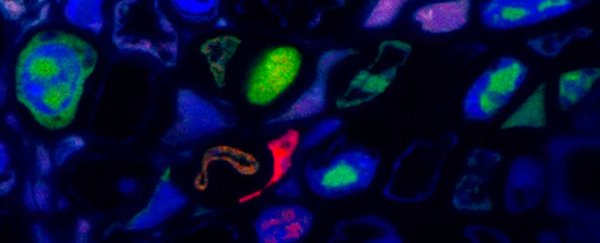Viruses are the IKEA furniture of the living world. In the right kind of cell, a handful of instructions and a few molecular tools can churn out multitudes of infectious Billy bookcases.
No DIY builder wants to travel all over town to gather materials - theoretically, germs shouldn't be any different. Yet a new discovery suggests at least one category of virus can still pull itself together even if its instructions are split up into separate cells.
A team of researchers from the Université de Montpellier in France recently conducted an experiment on a group of viruses with genomes made up of more than one distinct section.
What they found contradicted some pretty fundamental assumptions about how viruses reproduce.
To understand the weirdness of their discovery, we first need to back up a little to refresh the basics of virus construction. A typical virus is comprised of little more than nucleic acid inside a protective container.
Once smuggled inside a living cell, that nucleic acid sequence is either inserted into the host's own genetic library or used to coerce the cell's molecular assembly line into hammering together fresh copies of the virus.
Nearly all viruses encode their genetic blueprints on a length of single- or double-stranded nucleic acid. But some single-stranded DNA viruses described as 'multipartite' spread that code across multiple segments, each transmitted in a separate protein box.
It's like printing an IKEA manual on loose pages, and then forcing you to wait until an inept postal service delivers the full set of instructions. Sure, some people might be lucky enough to receive the full set, but it's hardly a good business model.
So it seems that by delivering their own pages of genetic instructions this way, multipartite viruses seem to be going about reproduction the hard way. Which prompts questions on why such a bizarre method of reproduction even persists.
But we can't really dismiss them - a variety of these serialised pathogens infect plants and fungi. Only a couple of years ago, one was found infecting animals for the first time. They're hardly doomed to extinction.
"The chances of a multipartite virus losing an essential genome segment during transmission are estimated to be so high, its ability to successfully cause an infection has been a long-standing mystery," says plant pathologist Anne Sicard.
Something in our understanding about how viruses reproduce has to give. Either complete sets of instructions are finding their way into single cells after all, or something unique is going on.
To dig deeper, the team used a faba bean necrotic stunt virus (FBNSV), a pathogen of peas and beans which is made up of eight viral 'chromosome' packages.
Fluorescent probes were then used to locate the end delivery points of distinct sections of the genome inside infected faba bean plants.
By using different colours of probe and testing for combinations of separated segments, the team were able to verify it was extremely unlikely for a full complement of genetic segments to randomly end up inside any one cell.
Yet that didn't seem to be preventing segments from being copied. This was true even for segments that weren't integral to the virus's most basic functions, such as replication, encapsidation, and movement within the host.
"Altogether, we have shown that distinct segments of a virus's genome are not necessarily together within individual host cells, and that accumulation of one genome segment in a cell is entirely independent of accumulation of the others," says virologist Stéphane Blanc.
The implications of the find suggest the products of one set of genetic instructions can have far-reaching influences, helping activate segments in other cells.
The researchers found evidence for this hypothesis when they looked for the molecule encoded by the genome segment responsible for replication. While fewer than half of the plant's cells contained copies of this replication segment, nearly 85 percent of its cells contained its product.
Strangely, this entire process more closely resembles the workings of a multicellular organism, with separate cells being forced to take on individualised tasks in the construction of a single virus.
"It is conceivable that this 'multicellular' way of life could be adopted in numerous viral systems and opens up an entirely new research horizon in virology," says Blanc.
This research was published in eLife.
